Higher classification Eriocheir Rank Species | Scientific name Eriocheir sinensis | |
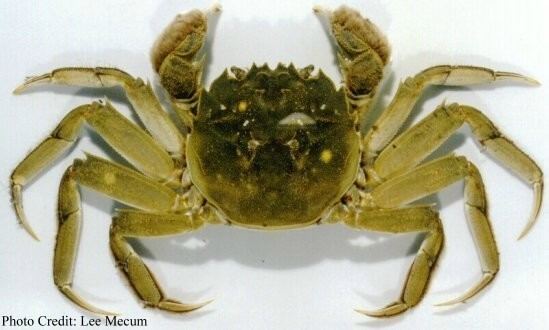 | ||
Similar Crab, Horsehair crab, Portunidae, Japanese mitten crab, Giant mud crab | ||
Chinese mitten crab eriocheir sinensis
The Chinese mitten crab (Eriocheir sinensis; Chinese: 大閘蟹, 大闸蟹, dàzháxiè, "big sluice crab"), also known as the Shanghai hairy crab (上海大闸蟹, Shànghǎi dàzháxiè), is a medium-sized burrowing crab that is named for its furry claws, which resemble mittens, and is native to the coastal estuaries of eastern Asia from Korea in the north to the Fujian province of China in the south. It has also been introduced to Europe and North America where it is considered an invasive species.
Contents
- Chinese mitten crab eriocheir sinensis
- Uk chinese mitten crabs causing chaos along river thames
- Description and ecology
- Invasiveness
- Culinary
- Management Efforts
- References
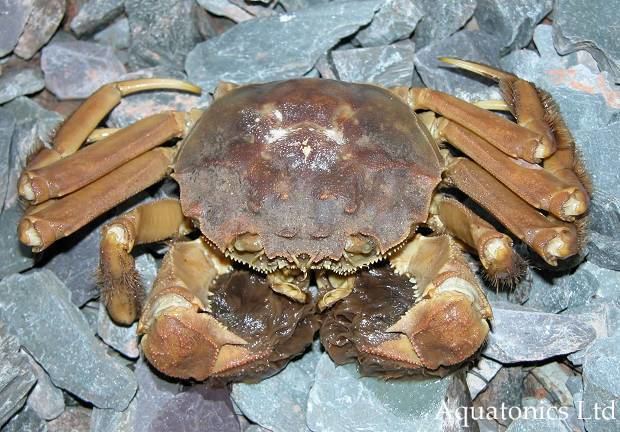
Uk chinese mitten crabs causing chaos along river thames
Description and ecology

This species' distinguishing features are the dense patches of dark setae on its claws. The crab's body is the size of a human palm. The carapace is 3–10 centimetres (1.2–3.9 in) wide, and the legs are about twice as long as the carapace is wide.
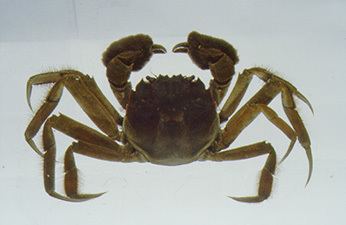
Mitten crabs spend most of their life in fresh water and return to the sea to breed. During their fourth or fifth year in late summer, the crustaceans migrate downstream and attain sexual maturity in the tidal estuaries. After mating, the females continue seaward, overwintering in deeper waters. They return to brackish water in the spring to hatch their eggs. After development as larvae, the juvenile crabs gradually move upstream into fresh water, thus completing the life cycle.
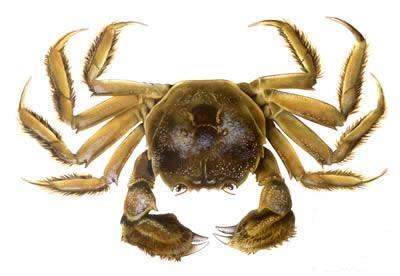
It moves from freshwater habitats to saltwater habitats once it has reached reproduction maturity. The types of estuaries suitable for the mitten crab is large brackish waters for the larva to develop in, and large shallow waters for the growth of the juvenile crabs.
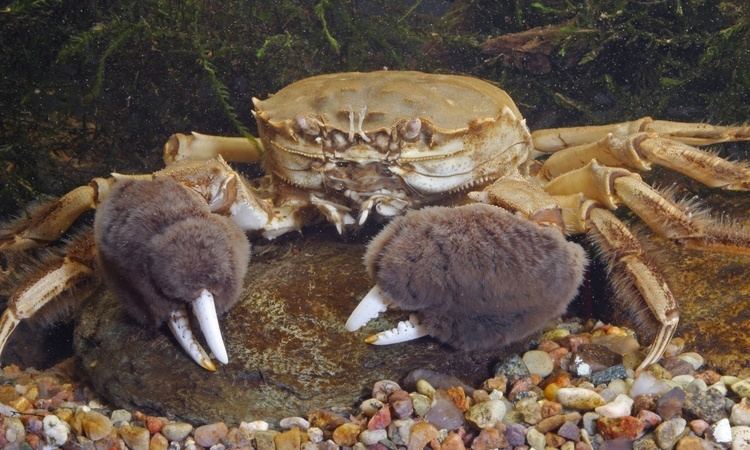
The Chinese Mitten Crab originates from Hong Kong to the border of Korea. It can be found inland but prefers coastal areas. It is known to settle in rice fields by the sea and rivers inland. The crab is found in temperate regions.
Phylogenetically the crab belongs to the Grapsoid family which is the newest group of brachyuran crustaceans. Spawning crabs average around 55mm in length. Since crabs spawn at the end of their life spans and perish at the end of the breeding cycle, the crabs can live up to 7 [in Germany also 8] years old.
The mitten crab diet is omnivorous. Their main prey consists of worms, mussels, snails, dead organic material, and other small crustaceans and fish.
Reproduction:
Starts off as a fresh-water organism. In late August the crab’s sexual instinct is awakened and they begin migrating downstream to the sea, away from their feeding grounds. It is during this migration where the crabs reach puberty and develop their sex organs. Late fall is when the crabs begin to breed in the brackish waters. The males arrive first and stay in the brackish waters all winter. The females arrive after the males arrive. The eggs are laid within 24 hours of mating. They are attached to the abdomen of the female crab. After the eggs are attached, the female leaves immediately heading to the mouth of the river. The larvae hatch from the eggs during summer and they float and drift about the brackish waters. Because the journey to breed for crabs is so great, they only breed once during their lifetimes. The breeding age is normally toward the end of their life spans. Since these crabs only breed once, they have very sizeable egg production counts. After the crabs successfully reproduce, they have very little energy and begin to waste away.
Different life stages of the mitten crab:
1) Eggs require pure salt water to mature. 2) Larvae hatch from the eggs in brackish waters. 3) The larvae gradually move from brackish water to fresh water. 4) The final stage of the larvae is the megalopa, which is 3-4mm in length. 5) The megalopa then develop into small mitten crabs in the freshwater.
Invasiveness
This species has been spread rapidly from Asia (China and Korea) to North America and Europe, raising concerns that it competes with local species, and its burrowing nature damages embankments and clogs drainage systems. The crabs can make significant inland migrations. It was reported in 1995 that residents of Greenwich saw Chinese mitten crabs coming out of the River Thames, and in 2014 one was found in the Clyde, in Scotland. The crabs have also been known to take up residence in swimming pools. In some places the crabs have been found hundreds of miles from the sea. There is concern in areas with a substantial native crab fishery, such as the Chesapeake Bay in Maryland and the Hudson River in New York (both locations where the crabs were first spotted in 2005), as the impact of the invasion by this species on the native population is unknown.
It is generally illegal to import, transport, or possess live Chinese mitten crabs in the United States, as accidental release or escape risks spreading these crabs to uninfested waters. In addition, some states may have their own restrictions on possession of mitten crabs. California allows fishing for mitten crabs with some restrictions.
The Chinese mitten crab has been introduced into the Great Lakes several times, but has not yet been able to establish a permanent population.
The Smithsonian is tracking the spread of the Chinese mitten crab and seeking help to determine the current distribution status of the mitten crab in the Chesapeake Bay region. People are encouraged to report any mitten crab sightings, along with details (date, specific location, size) and a close-up photograph or specimen if possible. The first confirmed record along the East coast of the United States was in the Chesapeake Bay near Baltimore, Maryland, in 2005.
Chinese mitten crabs have also invaded German waters, where they destroy fishing nets, hurt native fish species and damage local dams, causing damage of up to 80 million Euros. These crabs migrated from China to Europe as early as 1900, and were first documented by official German reports in 1912 from Aller River. After investigation by German scientists in 1933, it was thought that the crabs migrated to Europe through ballast water in commercial ships. The crabs are the only freshwater crab species in Germany, and their tendency to dig holes has caused damage to industrial infrastructure and dams.
The first time the crab was brought to Europe was most likely by commercial vessels. Ships must fill their ballast water tanks and during one of these filling events, it could have been the spawning time for the mitten crab. Since the larvae are free floating and 1.7mm to 5mm in size, it would have been easy for them to be swept into the ballast water tank. Once the ship reached Europe and emptied its tank, the crab larvae was released. Over time, this repetition would allow for a prominent mitten crab population in Europe. The crab has spread and can be found in Continental Europe, Southern France, United States of America (the San Francisco Bay), and the United Kingdom. A 15-year period in Germany when the crabs were gradually entering Europe is known as the “establishment phase.”
Culinary
The crab is an autumn delicacy in Shanghai cuisine and eastern China. It is prized for the female crab roe, which ripen in the ninth lunar month and the males in the tenth. The crab meat is believed by the Chinese to have a "cooling" (yin) effect on the body.
Chinese spend hundreds of yuan just to taste a small crab from Yangcheng Lake which are considered a delicacy. The crabs cost 680–700 yuan, or roughly US$105, per kilogram. Most of the Yangcheng crabs are exported to Shanghai and Hong Kong, and high-profit foreign markets. Responding to the spread of the crab to the West, businessmen have started seeing it as a new source of crab for the Chinese market. One proposed scheme involves importing unwanted crabs from Europe, where they are seen as a pest, to replenish local pure-bred stock.
Mitten crabs have exhibited a remarkable ability to survive in highly modified aquatic habitats, including polluted waters. Like some fish, they can also easily tolerate and uptake heavy metals, such as cadmium and mercury. Therefore, the farming and post-harvesting of the species needs proper management if it is used as a food. Concerns have been raised that the population and origin of the crab may be affected because of overfishing of the species in the Yangtze River.
Recently, China introduced vending machines to sell this species of crab in the subways. The crabs are stored at 5 °C (41 °F), which induces a sleepy state of hibernation. The prices of the crabs range from around $1.50 to $7.00 (USD).
Management Efforts
Management efforts have shown to be very difficult. This is due to its abundance, high reproductive rate, and high physiological tolerance. All the following efforts were attempted but showed little improvement: "catch as many as you can", migration barriers, trapping, raising awareness, electrical screens, and pulses.
There has been discussion of capturing the breeding crabs at the river mouths. There has been difficulties in carrying out this plan though. Other strategies such as capturing them when they pile up at dams has proven somewhat effective. The problem arises when the crabs climb the walls of the dams and over into the rivers behind the dams.
